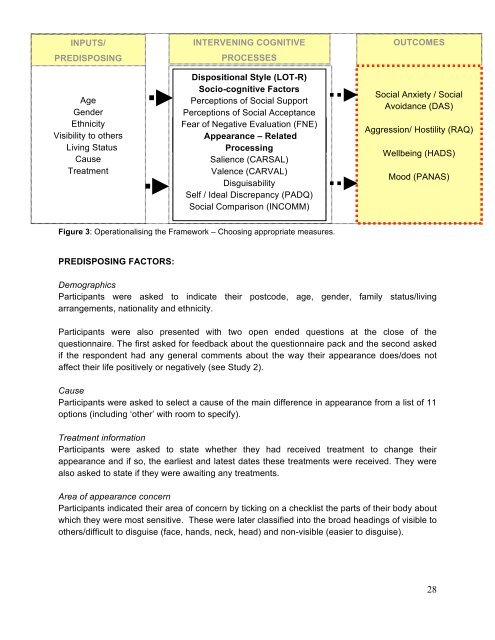Download the report - The Healing Foundation
Download the report - The Healing Foundation
Download the report - The Healing Foundation
Create successful ePaper yourself
Turn your PDF publications into a flip-book with our unique Google optimized e-Paper software.
INPUTS/<br />
PREDISPOSING<br />
FACTORS<br />
Age<br />
Gender<br />
Ethnicity<br />
Visibility to o<strong>the</strong>rs<br />
Living Status<br />
Cause<br />
Treatment<br />
Figure 3: Operationalising <strong>the</strong> Framework – Choosing appropriate measures.<br />
PREDISPOSING FACTORS:<br />
INTERVENING COGNITIVE<br />
PROCESSES<br />
Dispositional Style (LOT-R)<br />
Socio-cognitive Factors<br />
Perceptions of Social Support<br />
Perceptions of Social Acceptance<br />
Fear of Negative Evaluation (FNE)<br />
Appearance schema:<br />
Appearance – Related<br />
Processing<br />
Salience (CARSAL)<br />
Valence (CARVAL)<br />
Disguisability<br />
Self / Ideal Discrepancy (PADQ)<br />
Social Comparison (INCOMM)<br />
OUTCOMES<br />
Social Anxiety / Social<br />
Avoidance (DAS)<br />
Aggression/ Hostility (RAQ)<br />
Wellbeing (HADS)<br />
Mood (PANAS)<br />
Demographics<br />
Participants were asked to indicate <strong>the</strong>ir postcode, age, gender, family status/living<br />
arrangements, nationality and ethnicity.<br />
Participants were also presented with two open ended questions at <strong>the</strong> close of <strong>the</strong><br />
questionnaire. <strong>The</strong> first asked for feedback about <strong>the</strong> questionnaire pack and <strong>the</strong> second asked<br />
if <strong>the</strong> respondent had any general comments about <strong>the</strong> way <strong>the</strong>ir appearance does/does not<br />
affect <strong>the</strong>ir life positively or negatively (see Study 2).<br />
Cause<br />
Participants were asked to select a cause of <strong>the</strong> main difference in appearance from a list of 11<br />
options (including ‘o<strong>the</strong>r’ with room to specify).<br />
Treatment information<br />
Participants were asked to state whe<strong>the</strong>r <strong>the</strong>y had received treatment to change <strong>the</strong>ir<br />
appearance and if so, <strong>the</strong> earliest and latest dates <strong>the</strong>se treatments were received. <strong>The</strong>y were<br />
also asked to state if <strong>the</strong>y were awaiting any treatments.<br />
Area of appearance concern<br />
Participants indicated <strong>the</strong>ir area of concern by ticking on a checklist <strong>the</strong> parts of <strong>the</strong>ir body about<br />
which <strong>the</strong>y were most sensitive. <strong>The</strong>se were later classified into <strong>the</strong> broad headings of visible to<br />
o<strong>the</strong>rs/difficult to disguise (face, hands, neck, head) and non-visible (easier to disguise).<br />
28


